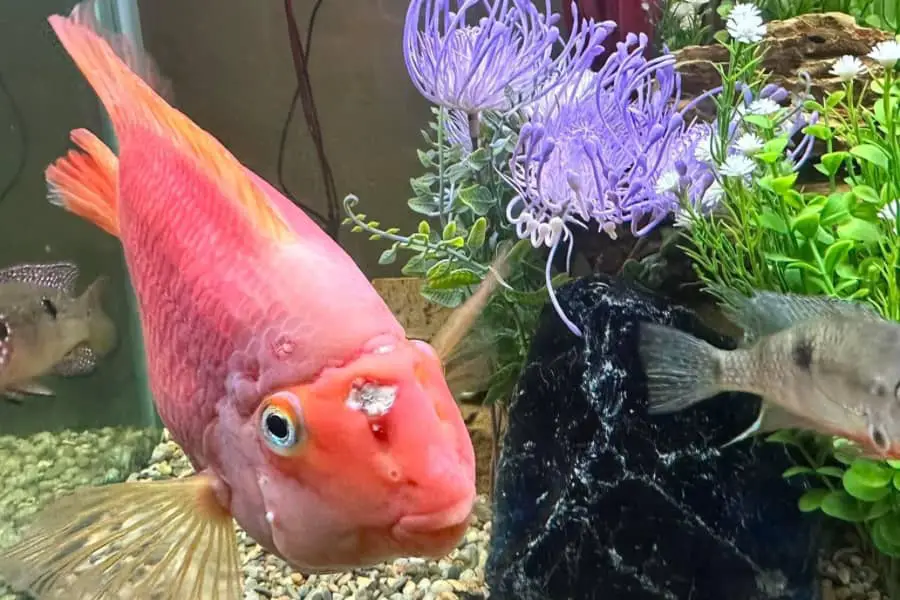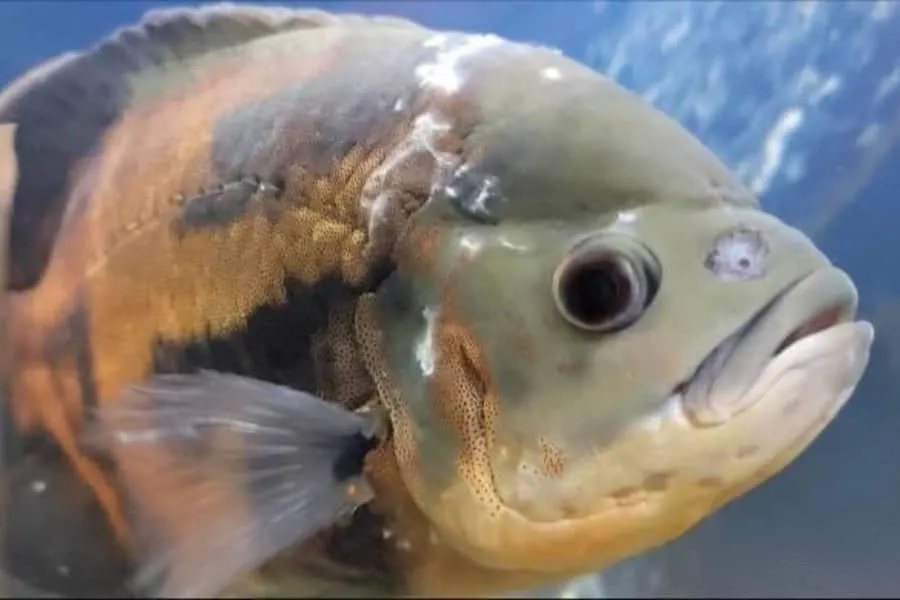This post may contain affiliate links.
If you see the tiny pits or lesions around the head area or down the lateral line of your fish, it’s probably the onset of the dreaded hole in the head disease, abbreviated as HITH. As easily treatable as this infection is, if neglected, the bacteria will eat away the flesh on the fish, leaving severely eroded pits in the affected area.
To know what hole-in-the-head disease looks like, including the causes and cure, read through the following sections. We have also shed light on the preventive measures you should consider to keep the hole in the head at bay.
What Is The Hole In Head Disease?

Hole In The Head Disease
True to its name, the hole in the head disease is explicitly what it sounds like. It’s an unpleasant-looking condition that usually manifests as small pitted lesions on the head and/or along the lateral line (referred to as lateral line erosion).
Although rarely fatal, HITH can lead to secondary bacterial infections, such as fin fraying and many others. The only way to safeguard your fish is to take control of the disease at the earliest.
Symptoms
The formation of a pimply-looking thing is a precursor sign of the hole in the head disease. When the pimple pops open, it becomes a hole or pit and starts to erode. It almost looks like the fish’s skin is receding or being eaten away.
These small raised lesions can form on the head region, along the nose, across the face, and down the lateral line.
As the disease progresses, the lesions tend to get bigger and deeper, eventually worsening in open ulcers. If not intervened, the disease will adversely affect the fish’s appetite and immune system making your aquatic pet susceptible to secondary infections.
What Causes Hole In Head Disease?
Despite being one of the common diseases in tropical pet fish, HITH has not been sufficiently studied, and therefore the causes are less conclusive.
Evidence suggests that there can be more than one culprit for this condition. The leading causative factors for the development of holes in the head include nutrient deficiency, poor water quality, and/or environmental stressors.
Although less common, other theories proposed issues with activated carbon filters or stray voltage as contributors to the hole in the head.
Poor Water Quality & Inappropriate Water Parameters
An aquarium with poor water quality is often a result of high levels of nitrates, dissolved organics, trace levels of ammonia or nitrite, and out-of-the-range pH.
To determine whether the crappy water quality is actually the cause of the hole in the head in your case, you need to test the water using the API Freshwater Master Test Kit (available online).
- If the test measures the presence of ammonia/nitrite or high levels of nitrates, it indicates that the filtration capacity of your tank is inadequate for the amount of food and biomass it contains. Moreover, it shows the lack of water changes and maintenance.
- To know if you have high levels of dissolved organics, look closely at the water. You may find nematodes, tiny little white worms that can be seen floating around the water column. Although harmless, nematodes in an aquarium speak of an underlying issue, especially unused organic material.
- Depending on the species of fish you have in the tank, the pH value must be in the recommended range.
- Also, you should try smelling the water, and if it smells like something you wouldn’t dare to swim in, know that the water quality is really bad. And that’s a perfect environment for HITH to flourish and wreak havoc.
Nutrition Deficiency
A poor diet that’s lacking in nutritional value is another major reason for the hole in the head disease.
For example, if you are feeding your fish only one type of food, such as too much live food. It doesn’t provide complete nutrition.
Being deprived of the essential amino, vitamins, and minerals, your aquatic pet becomes an easy target for various diseases and infections including holes in the head.
Stressful Conditions
Stress isn’t directly correlated to the hole in the head disease. However, when a fish is exposed to stressful conditions (especially prolonged or chronic stress) the immune system takes a toll which consequently compromises the fish’s ability to ward off diseases.
In fact, stress is the biggest contributor to sickness and health problems in aquarium fish. There are a number of things that can stress a fish, including:
- Poor water quality
- Too small tank size
- Inadequate nutrition
- Low dissolved oxygen
- Undesirable temperature or pH
- Sudden change in pH or temperature
- Overcrowding
- Fish bullying
The Truth About Hexamita Causing Hole In The Head
Hexamita, a protozoan parasite, is likely present in the intestines of many aquarium fish. But it’s at such low levels that is unable to cause any harm.
It’s only when a fish is stressed out, injured, or has a weak immune system, the Hexamita parasite can multiply rapidly and spread into the body causing adverse effects.
For a long time, the consensus was Hexamita being the cause for the hole in the head disease. However, there is no scientific evidence to support this claim.
According to Dr. Erik Johnson (a fish vet), during his examination of HITH cases, he found that the Hexamita parasite was present maybe half of the time, and the other half of the time there was no Hexamita at all. Even many of his clients have been able to successfully cure hole in the head disease without treating for the Hexamita.
NOTE: The only point we are trying to make is, if your fish is suffering from the hole in the head, it doesn’t necessarily mean the culprit is the Hexamita parasite. So, don’t think that simply treating the tank with Metronidazole medication would make the infection go away. Only after the sick fish is examined by a veterinarian, it can be determined whether the infection contains Hexamita.
NOTE 2: Hexamita-infected fish are usually seen producing white, stringy poop.
How To Treat Hole In The Head Disease?

Depending on what causes the HITH infection in your fish, you should take appropriate action. For instance, if the test results confirm that your water quality is crappy, fix it. Or, if it’s a case of malnutrition, change the diet.
If you don’t know what to do or how to do it, just follow the advice mentioned below:
Improve Environmental Conditions & Reduce Stress
Many fish owners have had luck successfully treating the hole in the head by simply improving the environment and taking the stress off the fish.
First and foremost you need to improve the water quality. It can be done by making larger water changes, higher water turnover, better oxygenation, and minimal organics in the system.
The next step is to identify the stressors (if any) and eliminate them. We have shared a list above that comprises the common environmental conditions infamous for inducing stress in fish.
Reportedly, in the majority of HITH cases, often it’s the smaller tank and overcrowding that’s a major problem. So, make sure it’s not the case with you.
Feed Well Balanced Diet & Introduce Supplements
A nutritionally rich, balanced diet is a must. Whether it’s a man or a fish, the dietary requirement must be fulfilled to stay healthy, free of diseases, and be able to function optimally.
Get a high-quality pellet food that offers complete nutrition to the species of fish you own. Putting your aquatic pet on a varied diet is extremely beneficial to avoid the risk of nutrient deficiency.
It’s important to note that if your fish already have HITH, switching to just another food may not be enough at the moment. You should supplement the diet with liquid vitamins and minerals for faster recovery.
Treat For Hexamita (If Needed)
In some cases, you may find the hole in the head disease is accompanied by the Hexamita parasite. In such instances, you will need to treat the tank with Metronidazole-based products – a prime medication for treating treating Hexamitiasis in fish.
The most effective approach is to treat orally by mediating the fish food. But, if your fish isn’t eating, the only option you are left with is dosing the tank.
NOTE: Remove the activated carbon from the aquarium (if you have any) for the time treatment continues. It’s of utmost importance to do so because of two reasons – first, the carbon tends to nullify the medicinal properties and second, activated carbon is linked with the hole in the head disease and head and lateral line erosion according to some studies.
Related Questions
Is the hole in the head disease curable?
Yes, HITH is easily curable. Unfortunately, the scar of the pitted wounds will remain even after the infection is long gone
Which fish are highly susceptible to HITH?
It includes Oscars, Angelfish, Discus, Piranha, Carps, Koi, Goldfish and Surgeonfish.
Final Words
Getting rid of the hole in the head disease is easy when you know how to do it the right way. And we hope, with the symptoms, causes, and cure we have shared in this article, you are well-equipped to cure your fish and feel confident tackling the disease if it ever shows up.
